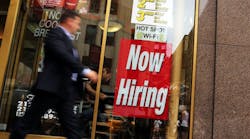Jobless Rate Falls to Nine-Year Low, but Factory Payrolls Fall
U.S. hiring picked up in November, while the unemployment rate tumbled to a nine-year low on a drop in the number of people in the workforce and wages unexpectedly declined, providing a mixed picture of the labor market.
The 178,000 gain followed a 142,000 rise in October that was less than previously estimated, a Labor Department report showed Friday. The median forecast in a Bloomberg survey called for a 180,000 advance. The jobless rate fell 0.3% points to 4.6% as labor participation dropped for a second month.
A steady job market signals employers were willing to keep hiring in the days before and after the Nov. 8 presidential election. At the same time, while the Federal Reserve is almost certain to raise borrowing costs this month, sustained weakness in wages or participation would weigh on the economic outlook.
“The labor market is still healthy, and perhaps operating at or beyond capacity,” said Michael Feroli, chief U.S. economist at JPMorgan Chase & Co. in New York. “Wages can be volatile month to month. I’d tend to put a little more weight on the unemployment rate when thinking about future developments and wage inflation.”
Revisions to prior reports subtracted a total of 2,000 jobs from payrolls in the previous two months.
November payroll estimates ranged from gains of 140,000 to 250,000. October was initially reported as a 161,000 increase.
Jobless Rate
The unemployment rate, which is derived from a separate Labor Department survey of households, was projected to hold at an eight-year low of 4.9%, according to the survey median.
Even with the tight labor market, the news on wages was disappointing. Average hourly earnings fell by 0.1% from the prior month to $25.89, the first decline since December 2014. They climbed 2.5% over the 12 months ended in November, following a 2.8% year-over-year gain in October. The average work week for all workers was unchanged at 34.4 hours.
Other measures continue to signal weaknesses that Donald Trump highlighted in the months leading up to his victory in the presidential election.
The participation rate, which shows the share of working-age people in the labor force, decreased to 62.7% last month from 62.8%. It has been hovering near the lowest level since 1978, with the longer-term slide mainly due to retiring baby boomers. Better employment prospects may draw more people into the workforce or limit unemployed Americans from giving up and dropping out.
The underemployment rate -- which includes part-time workers who’d prefer a full-time position and people who want to work but have given up looking -- fell 0.2 percentage point to 9.3%. While that’s the lowest since April 2008, it compares with 8.4% in November 2007, the month before the last recession began.
Part-Time Work
Americans who are working part time though would rather have a full time position, or the measure known as part-time for economic reasons, fell 220,000 to 5.67 million. That compares with 4.5 million just before the recession.
Companies continue to add jobs at a steady clip. Private employment, which excludes government agencies, rose by 156,000 after a 135,000 increase the prior month.
Government payrolls rose by 22,000, with employment at state and local agencies up 19,000.
The report showed differences across industries. Service providers, which include restaurants, business services and health-care, are typically less exposed to headwinds -- such as tepid overseas markets -- than manufacturers.
Payrolls at factories fell by 4,000, after a 5,000 decline in the previous month.
Retailers reduced payrolls by 8,300. Employment in leisure and hospitality rose by 29,000.
By Shobhana Chandra




